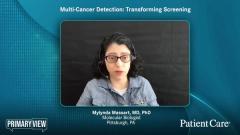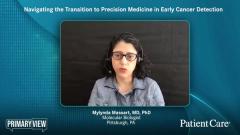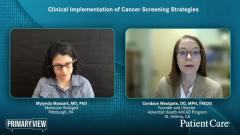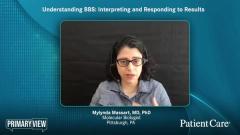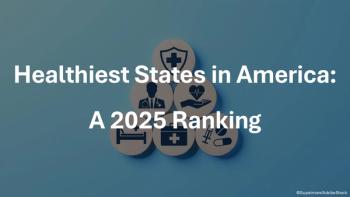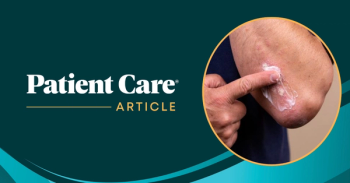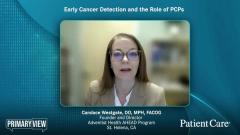
Clinical Implementation of Cancer Screening Strategies
Experts delve into the complexities of cancer screening, from identifying high-risk individuals to counseling patients about the nuances of screening tests, all while aiming for early detection and improved outcomes.
Episodes in this series

Transcript
Candace Westgate, DO, MPH, FACOG:Let’s shift gears a little bit and talk about what clinical implementation might look like. Let’s start by discussing the question of who to screen and who not to screen. So what do we know right now about the only test that’s available on the market for us, that Galleri test from GRAIL? Let’s start with who not to screen. And then let’s move on to who do you screen?
Mylynda Massart, MD, PhD:That’s a great question. And so who not to screen? We don’t want to do a bunch of screening on patients who have a low pretest probability. So this is very similar to ob-gyn where we screen pregnant women for prenatal screening. And we’re always thinking about that pretest probability vs that posttest probability. And with any screening tests, we want someone with a relatively significant pretest probability and then to have it drop to a very low posttest probability. If it goes to a high posttest probability, then we’re very concerned and we’re going to march forward toward diagnostic testing regardless of whether it’s prenatal screening or cancer screening. So what we don’t want to do is start screening everyone because the majority of the population is at low risk for having cancer at any given time. And so we would actually find more false positives if we were to screen a low pretest probability population—so young, healthy, those who are living good lifestyles, not smoking, not drinking a lot, are routinely exercising, having healthy nutrition, healthy weight management, don’t have a lot of environmental exposures, don’t have a huge family history or known hereditary cancer risk—that’s the population we don’t want to screen. Another population we don’t want to screen are people who currently have cancer. That doesn’t make sense. If someone currently has cancer, they should be screened positive. And also if they’re actively undergoing treatment, they’re having a lot of cell lysis, a lot of cell death and turnover, which is going to fill their bloodstream with cancerous cell-free DNA markers. And so we wouldn’t want to also screen anyone with current cancer undergoing current treatment for cancer.
Candace Westgate, DO, MPH, FACOG:When I considered ordering this test, my first approach was, OK, who should I screen? Is this going to overburden and bombard me with significant amount of time having to counsel patients about what this test is? And it’s not the same currently as, "Hey, it’s time for your mammogram. We do that on a yearly basis. You don’t have a family history and you don’t have dense breasts. So here’s your regular screening mammogram.” Our discussion with our current cancer screenings is a very simple one for our patients because it’s been out for a long period of time. However, when I started incorporating this MCED [multi-cancer early detection] test, I realized, OK, this is a different landscape. And there is a little bit of patient counseling that goes into the limitations of this kind of test and the fact that it’s just a screening test and we will need that diagnostic workup. So our approach within my clinic was to really take a look and identify those extremely high-risk individuals and offer them a little extra visit time so that we could do an appropriate informed consent process because this test is so new. Do I see this as something in the future we’re going to have to spend 15, 20 minutes counseling about this test? No. But currently that is where we live. So talk to me a little bit about how in your clinical setting, how you bring this up to a patient and talk to the patient about the test and what it’s all about.
Mylynda Massart, MD, PhD: I think you and I are really similar in how we approach this and because we both do see a slightly higher-risk population, we are taking into more consideration some additional factors. But in general, at the very baseline, everyone over the age of 50 is considered higher risk. And that’s just if you actually look at the incidence curves of cancer, you see this dramatic uptick occurs at age 50, where we are much more likely to have cancer develop. And so any patient who’s over 50 falls into that high-risk bucket that I’m going to consider offering this screening test to. In addition to that, [for] anyone who has a known hereditary cancer mutation…you and I both see those patients in our clinic…this is really great because it’s giving them a tool to supplement and complement their current screening. And [for] some of them, depending on the type of hereditary cancer syndromes, there really hasn’t been any screening available that’s been widely accepted or adopted because it’s just not that great. So this is really exciting for that patient population. In addition to that, we have patients who have strong family histories of cancer but have not had any hereditary cancer mutation identified, but they remain high risk by their family history. And then there’s patients who are high risk by additional factors, like maybe someone like me who did have a cancer 5 years or more ago and is currently considered cancer free and back in that screening, but slightly higher risk because of having the previous diagnosis, or an adult who had survived a child pediatric cancer and had radiation or chemotherapy, which could actually increase their risk for a second, new, unrelated cancer later in life. And then there’s other types of environmental exposures that we think about. So if someone’s a firefighter and they’re near carcinogens at a high rate or…I live in Pittsburgh, so we think about our mining rate and the waste that’s in our environment here. And then other intrinsic things like morbid obesity, which we know is an increased risk factor as well and other types of comorbid conditions. So really, again, getting back to that pretest probability and thinking who has a high pretest probability? So when I see that patient, that’s basically the question I’m asking myself: Does this patient have a high pretest probability for developing cancer? And therefore, I should think about offering that multi-cancer early detection.
Candace Westgate, DO, MPH, FACOG:Absolutely. And here in California, too, and in many parts of the United States, where agriculture is a big part of our communities, exposure to pesticides is also another big risk factor associated with developing cancer and just living in the world that we live in—exposure to UV rays from being outside in the sun. So we can’t get away from it. The goal here is to catch it early. We need to do something about it and improve outcomes.
Transcript was AI-generated and edited for clarity.
Newsletter
Enhance your clinical practice with the Patient Care newsletter, offering the latest evidence-based guidelines, diagnostic insights, and treatment strategies for primary care physicians.


